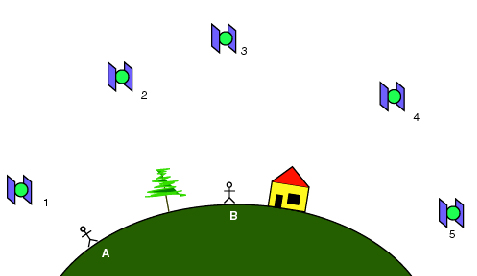ATLAS Worksheet: "Seeing" Satellites and Satellite
Visibility

One can "see" a GPS satellite if you can draw a straight line connecting
the GPS receiver to the GPS satellite that does not go through
any objects (including the Earth). In answering the following questions,
assume that the observers are holding their GPS receivers near their
heads.
- Which GPS satellites can Observer A see?
- Which GPS satellites can Observer B see?
- Which satellites can be seen by both Observers A and B?
(This is called "simultaneous visibility.")
- Which satellites cannot be seen by either Observer A or Observer B?
- If the tree were removed, which satellites would now become visible to Observor A?
To Observer B?
- Which satellites does the house prevent Observer A from seeing? Observer B?
- If the tree and the house were removed, which Observer
could detect all the satellites?
- If the tree and the house were removed, which Observer would
not be able to see all the satellites? Why not? (What gets in the way?)
- Draw an arrow indicating the direction that Satellite 5 would be moving
if it were rising from the Observers' viewpoint. Which Observer would see it first?
- Which satellites are visible more often, satellites directly overhead or
satellites near the horizon? Why?

